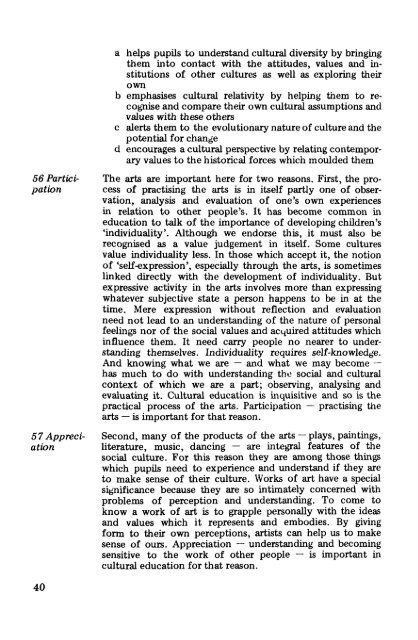The Arts in Schools - Calouste Gulbenkian Foundation
The Arts in Schools - Calouste Gulbenkian Foundation
The Arts in Schools - Calouste Gulbenkian Foundation
- No tags were found...
You also want an ePaper? Increase the reach of your titles
YUMPU automatically turns print PDFs into web optimized ePapers that Google loves.
a helps pupils to understand cultural diversity by br<strong>in</strong>g<strong>in</strong>gthem <strong>in</strong>to contact with the attitudes, values and <strong>in</strong>stitutionsof other cultures as well as explor<strong>in</strong>g theirownb emphasises cultural relativity by help<strong>in</strong>g them to recogniseand compare their own cultural assumptions andvalues with these otherse alerts them to the evolutionary nature of culture and thepotential for changed encourages a cultural perspective by relat<strong>in</strong>g contemporaryvalues to the historical forces which moulded them56 Partici- <strong>The</strong> arts are important here for two reasons. First, the propationcess of practis<strong>in</strong>g the arts is <strong>in</strong> itself partly one of observation,analysis and evaluation of one's own experiences<strong>in</strong> relation to other people's. It has become common <strong>in</strong>education to talk of the importance of develop<strong>in</strong>g children's'<strong>in</strong>dividuality'. Although we endorse this, it must also berecognised as a value judgement <strong>in</strong> itself. Some culturesvalue <strong>in</strong>dividuality less. In those which accept it, the notionof 'self-expression', especially through the arts, is sometimesl<strong>in</strong>ked directly with the development of <strong>in</strong>dividuality. Butexpressive activity <strong>in</strong> the arts <strong>in</strong>volves more than express<strong>in</strong>gwhatever subjective state a person happens to be <strong>in</strong> at thetime. Mere expression without reflection and evaluationneed not lead to an understand<strong>in</strong>g of the nature of personalfeel<strong>in</strong>gs nor of the social values and acquired attitudes which<strong>in</strong>fluence them. It need carry people no nearer to understand<strong>in</strong>gthemselves. Individuality requires self-knowledge.And know<strong>in</strong>g what we are — and what we may become —has much to do with understand<strong>in</strong>g the social and culturalcontext of which we are a part; observ<strong>in</strong>g, analys<strong>in</strong>g andevaluat<strong>in</strong>g it. Cultural education is <strong>in</strong>quisitive and so is thepractical process of the arts. Participation — practis<strong>in</strong>g thearts — is important for that reason.57 Appreci- Second, many of the products of the arts — plays, pa<strong>in</strong>t<strong>in</strong>gs,ation literature, music, danc<strong>in</strong>g — are <strong>in</strong>tegral features of thesocial culture. For this reason they are among those th<strong>in</strong>gswhich pupils need to experience and understand if they areto make sense of their culture. Works of art have a specialsignificance because they are so <strong>in</strong>timately concerned withproblems of perception and understand<strong>in</strong>g. To come toknow a work of art is to grapple personally with the ideasand values which it represents and embodies. By giv<strong>in</strong>gform to their own perceptions, artists can help us to makesense of ours. Appreciation — understand<strong>in</strong>g and becom<strong>in</strong>gsensitive to the work of other people — is important <strong>in</strong>cultural education for that reason.40
















